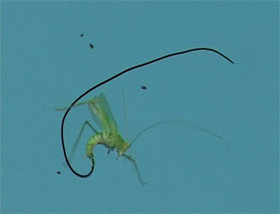Suicide Grasshoppers Brainwashed by Parasite Worms
Parasites were the inspiration behind the creature that terrified moviegoers in Alien. Now sci-fi screenwriters may have a new role model—parasitic worms that brainwash their victims.
Scientists say hairworms, which live inside grasshoppers, pump the insects with a cocktail of chemicals that makes them commit suicide by leaping into water. The parasites then swim away from their drowning hosts to continue their life cycle.
A team of French biologists made the discovery after monitoring grasshoppers that became trapped in a swimming pool in southern France.
Postmortems of the grasshoppers suggest that worms triggered the insects' death leaps by sabotaging their central nervous systems.
Writing this week in the journal Proceedings of the Royal Society B, the team says their findings help explain how parasites are able to manipulate their hosts' behavior to the parasites' own ends.
Scientists have long argued whether strange behavior in parasite-infested animals is deliberately engineered or simply an accidental side effect of infection.
The new study suggests the former, says David G. Biron of the Laboratory of Genetics and Evolution of Infectious Diseases at France's National Scientific Research Center in Montpellier.
Biron said hairworms control their hosts to "enhance the parasite's chances of completing its life cycle."
Adult hairworms breed in water, where they form writhing masses. It's still not clear how their young get into grasshoppers, though Biron says it may happen when the insects drink larvae-infested water.
Emerging Worms
When the hairworm is full-grown "it occupies most of the host's cavity, with the exception of the head and the legs," he said. "Worms are only ready to emerge once they reach this stage."
Hugh Loxdale, president of the London-based Royal Entomological Society, traveled to France last month to see what happens next.
MOST POPULAR STORIES
Photo in the News: Oldest Known Maya Mural Reveals Royal TaleArchaeologists have revealed the final wall of the earliest known Maya mural, sa... |
Oldest Known Maya Mural, Tomb Reveal Story of Ancient KingArchaeologists have revealed the final wall of the earliest known Maya mural, sa... |
King Kong Island Home Is Pure Fantasy, Ecology Experts SaySkull Island, the mythical home of the great ape King Kong, is supposed to lie i... |
|
||||||||||









